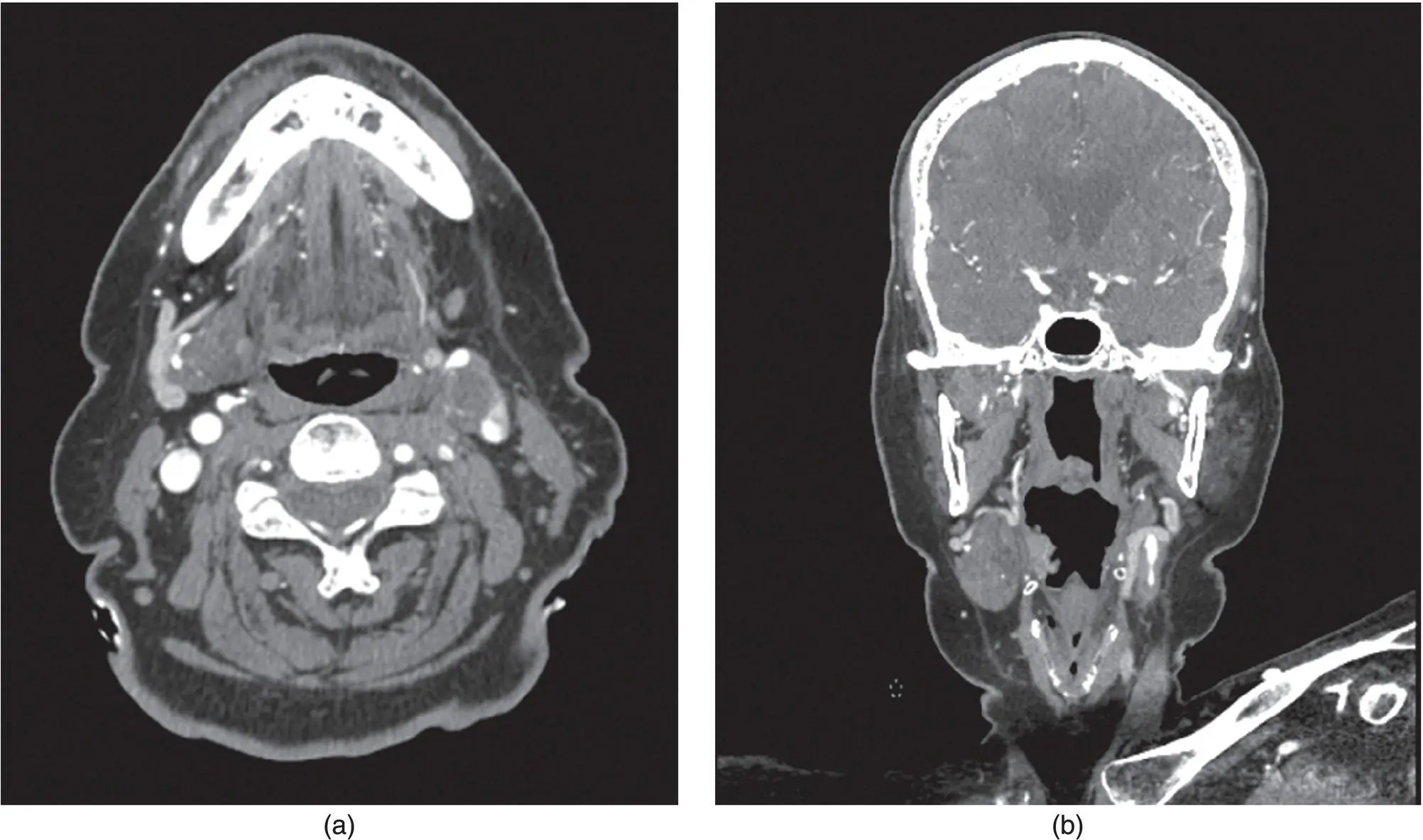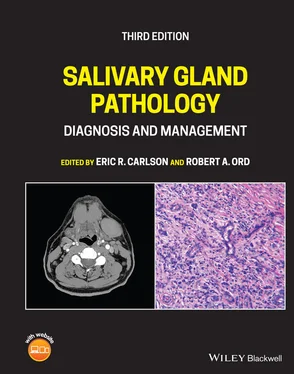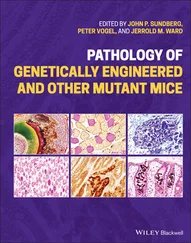A 67‐year‐old man presented to the emergency department with an abrupt onset of acute left visual loss. The patient had a known history of multiple cerebrovascular accidents and had chronic right visual loss and a chronic mild aphasia.
The patient had a history of hypercoagulable state with methylenetetrahydrofolate reductase (MTHFR) mutation, hypertension, hyperlipidemia, peripheral vascular disease, and gastroesophageal reflux disease. He had undergone a left carotid endarterectomy in the past and a bypass surgery for peripheral vascular disease. He was taking a baby aspirin daily, atorvastatin, hydrochlorothiazide, metoprolol, niacin, ranitidine, and warfarin that was on hold for five days for a planned vascular surgery procedure.
The patient underwent a CT of the head that demonstrated multiple remote infarcts with no acute findings. A CT angiogram of the brain and neck revealed occlusive disease of the left internal carotid artery and absence of his left submandibular gland ( Figure 1.15a and b).

Figure 1.15. Axial (a) and coronal (b) CT angiogram of the neck demonstrating agenesis of the left submandibular gland. Hypertrophy of the right submandibular gland is noted.
Congenital absence of the left submandibular gland. The patient's operative report for his left carotid endarterectomy made no mention of encountering or removing the left submandibular gland.
1 Unilateral or bilateral agenesis of the submandibular glands is extremely rare.
2 Unilateral submandibular gland agenesis is typically asymptomatic and discovered incidentally through imaging of the neck. Bilateral agenesis is more likely to produce symptoms in affected patients such as xerostomia, dysphagia, and dental problems.
3 Submandibular gland agenesis may be accompanied by genetic syndromes such as Treacher Collins syndrome, hemifacial microsomia, ectodermal dysplasia, and lacrimo‐dento‐digital syndrome.
4 Physical examination of the neck might not disclose unilateral or bilateral agenesis of the submandibular glands. It becomes necessary, therefore, to examine the oral cavity where the unilateral Wharton duct opening may not be present. CT or MR imaging of the neck will unequivocally establish the diagnosis of agenesis of the submandibular gland as this case demonstrated.
1 Berkovitz BKB, Moxham BJ. 1988. A Textbook of Head and Neck Anatomy. London, Wolfe.
2 Berkovitz BKB, Langdon JD, Moxham BJ. 2003. The Facial Nerve and the Parotid Gland. In: Langdon JD, Berkovitz BKB, Moxham BJ (eds.) Surgical Anatomy of the Infratemporal Fossa. London, Martin Dunitz, pp. 181–206.
3 Bernstein L, Nelson RH. 1984. Surgical anatomy of the extraparotid distribution of the facial nerve. Arch Otolaryngol 110:177–183.
4 Berta E, Bettega G, Jouk PS . 2013. Complete agenesis of major salivary glands. Int J Pediatr Otorhinolaryngol 77:1782–1785.
5 Chadi MJ, Saint Georges G, Albert F, Mainville G, Nguyen JM, Kauzman A. 2017. Major salivary gland aplasia and hypoplasia in Down syndrome: Review of the literature and report of a case. Clin Case Rep 5:939–944.
6 Davis RA, Anson BJ, Budinger JM, Kurth LE. 1956. Surgical anatomy of the facial nerve and parotid gland based on 350 cervicofacial halves. Surg Gynecol Obstet 102:385–412.
7 Ellis H. 1997. Clinical Anatomy, 9th edn. Oxford, Blackwell.
8 Flatau AT, Mills PR. 1995. Regional Aanatomy. In: de Norman JEB, McGurk M (eds.) Color Atlas and Text of the Salivary Glands. London, Mosby Wolfe, pp. 13–39.
9 Gareta‐Crelgo J, Gay‐Escoda C, Bermejo B, Buenechea‐Imaz R. 1993. Morphological studies of the parotid lymph nodes. J Cranio‐Maxillo‐Facial Surg 21:207–209.
10 Garrett JR, Kidd A. 1993. The innervation of salivary glands is revealed by morphological studies. Microsc Res Tech 26:75–91.
11 Goldenberg D, Flax‐Goldenberg R, Joachims HZ, Peled N. 2000. Misplaced parotid glands: Bilateral agenesis of parotid glands associated with bilateral accessory parotid tissue. J Laryngol Otol 114:883–885.
12 Gosain AK, Yousif NJ, Madiedo G et al. 1993. Surgical anatomy of the SMAS: A reinvestigation. Plast Reconstr Surg 92:1254–1263.
13 Hawthorn R, Flatau A. 1990. Temporomandibular Joint Anatomy. In: de Norman JEB, Bramley P (eds.) A Textbook and Colour Atlas of the Temporomandibular Joint. London, Mosby Wolfe, pp. 1–51.
14 Holt JJ. 1996. The stylomastoid area: Anatomic‐histologic study and surgical approach. Laryngoscope 106:396–399.
15 Ji YD, Donoff RB, Peacock ZS, Carlson ER. 2018. Surgical landmarks to locating the main trunk of the facial nerve in parotid surgery: A systematic review. J Oral Maxillofac Surg 76:438–443.
16 Jost G, Levet Y. 1983. Parotid fascia and face lifting: A critical evaluation of the SMAS concept. Plast Reconstr Surg 74:42–51.
17 Kulkarni CD, Mittal SK, Katiyar V, Pathak O, Sood S. 2011. Accessory parotid gland with ectopic fistulous duct‐diagnosis by ultrasound, digital fistulography, digital sialography and CT fistulography. A case report and review of current literature. J Radiol Case Rep 5:7–14.
18 Langdon JD. 1998a. Sublingual and Submandibular Gland Excision. In: Langdon JD, Patel MF (eds.) Operative Maxillofacial Surgery. London, Chapman & Hall, pp. 376–380.
19 Langdon JD. 1998b. Parotid Surgery. In: Langdon JD, Patel MF (eds.) Operative Maxillofacial Surgery. London, Chapman & Hall, pp. 386–388.
20 Marks NJ. 1984. The anatomy of the lymph nodes of the parotid gland. Clin Otolaryngol 9:271–275.
21 McKean ME, Lee K, McGregor IA. 1984. The distribution of lymph nodes in and around the parotid gland: An anatomical study. Br J Plast Surg 38:1–5.
22 McMinn RMH, Hutchings RT, Logan BM. 1984. A Colour Atlas of Applied Anatomy. London, Wolfe.
23 Meningaud J‐P, Bertolus C, Bertrand J‐C. 2006. Parotidectomy: Assessment of a surgical technique including facelift incision and SMAS advancement. J Cranio‐Maxillofacial Surg 34:34–37.
24 Mitz V, Peyronie M. 1976. The superficial musculo‐aponeurotic system (SMAS) in the parotid and cheek area. Plast Reconstr Surg 58:80–88.
25 Proctor GB, Carpenter GH. 2007. Regulation of salivary gland function by autonomic nerves. Auton Neurosci 133:3–18.
26 Thaller SR, Kim S Patterson H et al. 1989. The submuscular aponeurotic system (SMAS): A histologic and comparative anatomy evaluation. Plast Reconstr Surg 86:691–696.
27 Valstar MH, de Bakker BS, Steenbakkers RJHM et al. 2020. The tubarial salivary glands: A potential new organ at risk for radiotherapy. Radiother Oncol. https://doi.org/10.1016/j.radonc.2020.09.034.
28 Wassef M. 1987. Superficial fascia and muscular layers in the face and neck: A histological study. Aesthetic Plast Surg 11:171–176.
29 Williams PL (ed.). 1995. Gray’s Anatomy, 38th edn. Oxford, Blackwell.
30 Zhang L, Xu H, Cai ZG, Mao C, Wang Y, Peng X. 2010. Clinical and anatomic study of the ducts of the submandibular and sublingual glands. J Oral Maxillofac Surg 68:606–610.
31 Zigiotti GL, Liverani MB, Ghibellini D. 1991. The relationship between parotid and superficial fasciae. Surg Radiol Anat 13:293–300.
Chapter 2 Diagnostic Imaging of Salivary Gland Pathology
J. Michael McCoy DDS, FACS1 and Pradeep K. Jacob MD, MBA2
1Departments of Oral and Maxillofacial Surgery, Pathology, and Radiology, University of Tennessee Medical Center, Knoxville, TN, USA
Читать дальше













